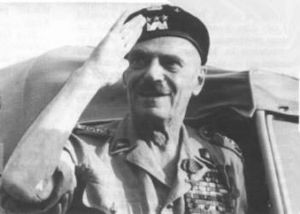Władysław Anders facts for kids
Quick facts for kids
General
Władysław Anders |
|
|---|---|
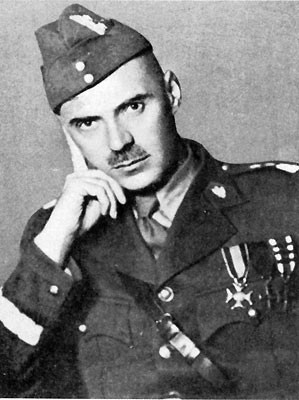 |
|
| Birth name | Władysław Albert Anders |
| Born | 11 August 1892 Krośniewice-Błonie, Warsaw Governorate, Congress Poland, Russian Empire |
| Died | 12 May 1970 (aged 77) London, United Kingdom |
| Years of service | 1913–1946 |
| Rank | Lieutenant General (Polish: Generał Broni) |
| Unit | Polish II Corps |
| Battles/wars | First World War Polish–Bolshevik War Second World War
|
| Awards | See list below |
| Spouse(s) |
|
| Relations |
|
| Signature | |
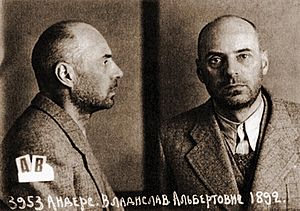
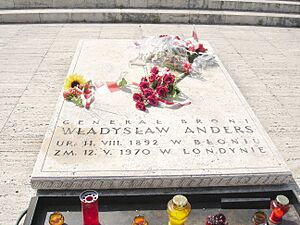
Władysław Albert Anders (born August 11, 1892 – died May 12, 1970) was a brave general in the Polish Army. Later in his life, he became an important politician and a key member of the Polish government-in-exile in London.
Władysław Anders was born in 1892 in Krośniewice-Błonie, which was then part of the Russian Empire. He fought in the Imperial Russian Army during World War I. After Poland became independent in 1918, he joined the new Polish Land Forces.
During World War II, Soviet forces captured Anders and put him in prison. However, he was later set free to create a Polish Army. This army would fight alongside the Red Army against the Germans. He led the Polish II Corps through the Italian Campaign. This included the famous capture of Monte Cassino.
After the war, the new communist government in Poland took away his citizenship and military rank. Anders stayed in Britain and worked for the Polish Government in Exile. He also helped many charities. In 1989, after communism ended in Poland, his citizenship and rank were given back to him.
Contents
General Anders's Life Story
Early Life and Military Career
Anders was born on August 11, 1892. His parents were Albert and Elizabeth Anders. They lived in the village of Krośniewice–Błonie, about 96 kilometers west of Warsaw. This area was part of the Russian Empire at the time. His parents were of German background, and he was baptized in a Protestant church. Władysław had three brothers, Karol, Tadeusz, and Jerzy. All of them also became military officers.
Anders went to a technical high school in Warsaw. Then he studied at Riga Technical University. After finishing university, he joined the Russian Military School for reserve officers. As a young officer, he served in the 1st Krechowiecki Lancers Regiment. This was part of the Imperial Russian Army during World War I.
When Poland became independent in November 1918, Anders joined the new Polish Land Forces. During the Polish–Soviet War (1919–1921), he led the 15th Poznań Uhlans Regiment. For his bravery, he received the Silver Cross of the Virtuti Militari. After the war, Anders continued his military training in France. He studied at the École spéciale militaire de Saint-Cyr. When he returned to Poland, he worked for the general staff of the Polish Army. He served under General Tadeusz Jordan-Rozwadowski.
In 1926, Anders did not support Józef Piłsudski's May Coup. But unlike some others, he was not punished by the new government. In 1931, Piłsudski made him the commander of a cavalry brigade. Three years later, he was promoted to the rank of general.
Anders in World War II
In September 1939, Germany invaded Poland. Anders was commanding the Nowogródzka Cavalry Brigade. He immediately joined the fight in the Battle of Mława. After the Polish Northern Front collapsed, his brigade moved back towards Warsaw. They fought hard battles against the Germans near Mińsk Mazowiecki. They also fought in the second part of the Battle of Tomaszów Lubelski.
When Anders learned about the Soviet invasion of Poland, he moved his troops south. He hoped to reach the Hungarian or Romanian border. But Soviet forces stopped him and captured him on September 29. He was wounded twice during this time.
Anders was first held in Lwów. Then, on February 29, 1940, he was moved to the Lubyanka prison in Moscow. While imprisoned, he was questioned and tortured. The Soviets tried to make him join the Red Army, but he refused.
After Germany attacked the Soviet Union (called Operation Barbarossa), Anders was released. This happened after the Sikorski-Maisky agreement was signed. The Soviets wanted him to form a Polish Army to fight Germany with them. However, there were many disagreements with the Soviets. There were also shortages of weapons, food, and clothing.
Because of these problems, Anders's men, known as Anders' Army, were moved out of the Soviet Union. Many Polish civilians who had been sent to the USSR also left with them. They traveled through the Persian Corridor to Iran, Iraq, and finally Mandatory Palestine. This move happened in March 1942. The soldiers then came under British command. Here, Anders created and led the Polish II Corps. He also kept pushing for other Polish people still in the Soviet Union to be released.
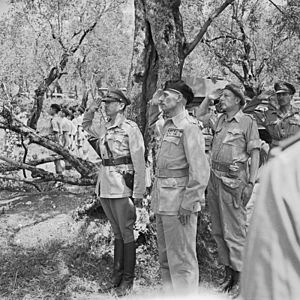
The Polish II Corps became a very important fighting unit for the Polish Armed Forces in the West. Anders led the Corps throughout the Italian Campaign. They captured Monte Cassino on May 18, 1944. They also took Ancona on July 18, 1944. Later, his Corps helped break through the Gothic Line. They also took part in the final spring offensive.
The Polish soldiers felt discouraged after the Yalta Conference on February 11. At this meeting, the British and Americans decided to give a large part of Poland's land to the Soviet Union. They did this without asking the Poles. Anders wanted to pull his unit from the front lines. Winston Churchill told him, "you [the Poles] are no longer needed." But the American and British commanders, Generals Richard McCreery, Mark Wayne Clark, and Field Marshal Harold Alexander, asked Anders to keep his units fighting. They had no other troops to replace them. Anders decided to keep the Polish units involved. So, they fought with the Allies in the Battle of Bologna.
Life After World War II
After the war, the new communist government in Poland took away Anders's Polish citizenship and military rank. Anders did not want to return to a Poland controlled by the Soviets. He knew he would likely be jailed or even executed. So, he stayed in Britain.
He was a very important figure in the Polish Government in Exile in London. He became the General Inspector of the Armed Forces. He also worked for many charities and welfare groups. His book, An Army in Exile, was published in 1949. It tells about his experiences during World War II.
Anders passed away in London on May 12, 1970. His body was displayed at St Andrew Bobola Church, Hammersmith. Many of his former soldiers and their families came to say goodbye. He was buried, as he wished, among his fallen soldiers from the 2nd Polish Corps. His grave is at the Polish War Cemetery at Monte Cassino in Italy. After communism ended in Poland in 1989, his citizenship and military rank were given back to him.
Many of Anders's personal items are now on display. You can see them at the Polish Institute and Sikorski Museum in London. In June 2021, a bust (a statue of his head and shoulders) of General Anders was shown. It was designed by Andrzej Pitynski. This bust is now at London's National Army Museum.
Family Life
Anders was married two times. He had two children with his first wife, Irena Maria Jordan-Krąkowska. Their daughter, Anna, was born in 1919. Their son, George, was born in 1927.
In 1948, he married the actress and singer Irena Jarosiewicz. She was also known as Renata Bogdańska. They had a daughter named Anna Maria, born in 1950.
Medals and Awards
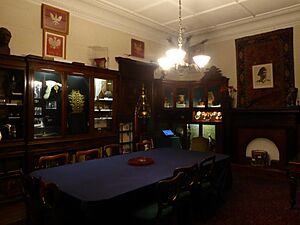
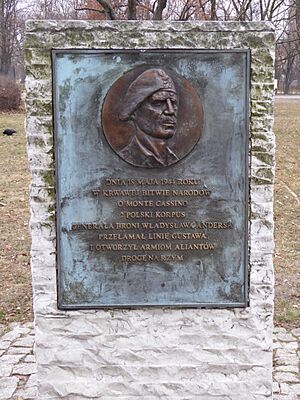
General Anders received many awards and decorations for his service. Here are some of them:
Poland
 Order of the White Eagle (awarded after his death in 1995)
Order of the White Eagle (awarded after his death in 1995)- Virtuti Militari
- Order of Polonia Restituta
 Cross of Independence
Cross of IndependenceCross of Valour (four times)
 Gold Cross of Merit with Swords (four times)
Gold Cross of Merit with Swords (four times) Army Medal (four times)
Army Medal (four times) Commemorative Medal for War 1918–1921
Commemorative Medal for War 1918–1921 Medal of the 10th Anniversary of Independence
Medal of the 10th Anniversary of Independence- Medal of 3rd May
- Medal for Long Service
 Home Army Cross
Home Army Cross Monte Cassino Commemorative Cross
Monte Cassino Commemorative Cross- Wound Decoration, (eight times)
Foreign Awards
- Czechoslovakia
- France
 Commander of the Légion d'honneur
Commander of the Légion d'honneur Croix de Guerre avec Palme
Croix de Guerre avec Palme Médaille Interalliée de la Victoire 1914–1918
Médaille Interalliée de la Victoire 1914–1918
- Italy
- Grand Cross of Merit
- Imperial Russia
 Order of St. George (4th class, 1915)
Order of St. George (4th class, 1915) Order of St. Vladimir with Swords (4th class, 1915)
Order of St. Vladimir with Swords (4th class, 1915) Order of St. Anna with Swords (2nd, 3rd (1918) and 4th class)
Order of St. Anna with Swords (2nd, 3rd (1918) and 4th class)Order of Saint Stanislas with Swords (2nd and 3rd classes, 1918)
- United Kingdom
- United States of America
More to Explore
 In Spanish: Władysław Anders para niños
In Spanish: Władysław Anders para niños
- Other famous Poles
- Anders' Army
- Anders (tank)
- History of Poland (1939–45)
- Polish Armed Forces in the East
- Polish Armed Forces in the West
- Polish contribution to World War II
- Polish government-in-exile
- Western betrayal



